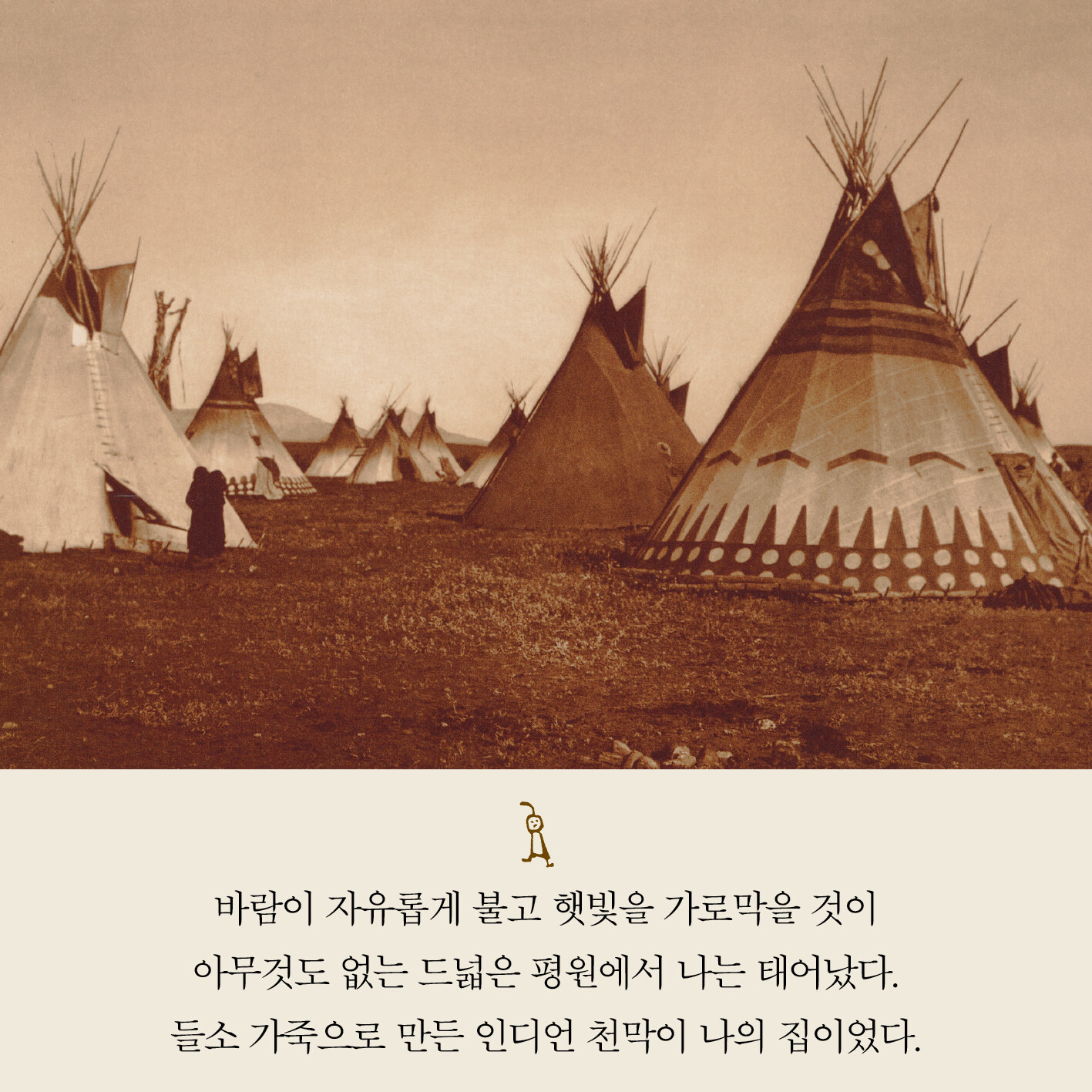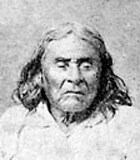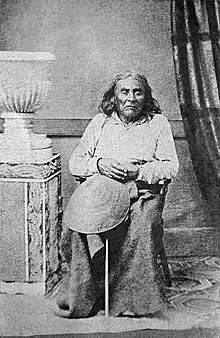알라딘: 나는 왜 너가 아니고 나인가 - 인디언 연설문집
[eBook] 나는 왜 너가 아니고 나인가 - 인디언 연설문집



시애틀 추장 (지은이), 류시화 (엮은이) | 더숲 | 2017-11-24



전자책 미리 읽기
종이책
미리보기



페이지 수 906쪽 (종이책 기준)
제공 파일 ePub(33.64 MB)
T




수만 년 전부터 '거북이섬'이라 불린 북미 대륙에서 살아온 아메리카 원주민들의 삶과 문화에 대한 이야기이다. 총과 병균과 종교를 앞세우고 쳐들어 온 백인들에게 터전을 빼앗기고 물러가면서 그들이 남긴 명연설들을 모은 것이다. 단순하면서도 시적인 그들의 연설은 오만한 백인 문명의 허구뿐 아니라 오늘을 사는 우리의 삶과 정신세계를 날카롭게 지적하고 있다.
류시화 시인이 수집하고 우리말로 옮긴, 아메리카 인디언 역사에 길이 남을 41편의 명연설과 해설, 그리고 그들이 남긴 희귀한 어록까지 총망라하고 있다. 또한 평생 아메리카 인디언의 모습을 촬영한 에드워드 커티스의 뛰어난 사진들과 독특한 인디언 달력까지 담고 있어 인디언에 대한 거의 모든 것을 집대성한 책이라 할 수 있다.
15년에 걸친 오랜 집필 기간과 방대한 양의 자료 수집을 통해 이뤄낸 결과물이다. 1993년 첫 발간 이후 개정을 거듭하여 900쪽에 이르는 방대한 작업이 되었으며, 많은 사람들이 인생에서 꼭 읽어야 할 책으로 꼽을 만큼 인디언들의 북소리처럼 울림이 큰 책이다. 2010년 절판된 이후 수많은 독자들이 재출간을 기다려 온 책이기도 하다.
시애틀 추장, 조셉 추장, 앉은 소, 구르는 천둥, 빨간 윗도리, 검은 새, 열 마리 곰… 이들은 자신들의 삶의 방식을 지키기 위해 끝까지 싸운 위대한 인디언 전사들이다. 이들의 연설문 속에는 자신들의 세계와 생명의 근원인 대지가 여지없이 파괴되는 것을 지켜보던 인디언들의 슬픔과 지혜, 그리고 비굴하지 않은 당당한 종말이 그대로 녹아 있다.

개정판 서문 우리는 모두 연결되어 있다
서문 인디언의 혼을 갖고 태어나
- 어떻게 공기를 사고판단 말인가 | 시애틀 추장
- 이 대지 위에서 우리는 행복했다 | 빨간 윗도리
- 연어가 돌아오는 계절 | 시애틀 추장
- 인디언의 영혼 | 오히예사
- 이해할 수 없는 것 | 오히예사의 삼촌
- 고귀한 붉은 얼굴의 연설 | 조셉 추장
- 평원에서 생을 마치다 | 열 마리 곰
- 내 앞에 아름다움 내 뒤에 아름다움 | 상처 입은 가슴
- 말하는 지팡이 | 이름이 알려지지 않은 추장
- 대지가 존재하는 한 | 테쿰세
- 우리가 잃어버린 것들 | 텐스콰타와
- 대지를 사랑한 것이 죄인가 | 검은 매
- 콜럼버스의 악수 | 쳐다보는 말
- 말과 침묵 | 서 있는 곰
- 가난하지만 자유롭다 | 앉은 소
- 당신들은 만족할 줄 모른다 | 메테아
- 강은 이제 깨끗하지 않다 | 명사수
- 나는 왜 거기 있지 않고 여기 있는가 | 어느 인디언 여자
- 이름으로 가득한 세상 | 느린 거북
- 우리는 언제나 이곳에 있었다 | 샤리타리쉬
- 나는 왜 너가 아니고 나인가 | 붉은 구름
- 자유롭게 방랑하다 죽으리라 | 사탄다
- 겨울 눈으로부터 여름 꽃에게로 | 구르는 천둥
- 시간이 우리를 데려다주리라 | 불타는 화살
- 부족의 어른이 말한다 | 방랑하는 늑대
- 나는 왜 이교도인가 | 붉은 새
- 내가 흘린 눈물만 모아도 가뭄은 없다 | 후아니타 센테노
- 나는 노래를 불렀다, 인디언의 노래를 | 댄 조지 추장
- 집으로 가는 길 | 파란 독수리 깃털
- 좋은 약은 병에 담겨 있지 않다 | 미친 곰
- 기억하라, 세상의 신성한 것들을 | 토머스 반야시아
- 마음과 영혼과 육체 | 비키 다우니
- 나는 인디언이지 캐나다 인이 아니다 | 홀로 서 있는 늑대
- 꽃가루를 뿌리면 비가 내렸다 | 아사 바즈호누다
- 인디언들이 아메리카에 전하는 메시지 | 이로쿼이 인디언 선언문
- 아메리카는 언제 재발견될 것인가 | 브루키 크레이그
- 여기 치유의 힘이 있으니 | 라모나 베네트
- 야생이란 없다, 자유가 있을 뿐 | 오렌 라이온스
- 독수리의 여행 | 이름이 알려지지 않은 인디언
- 아메리카 인디언 도덕률 | 인터트라이벌 타임스
- 인디언 남자들의 일곱 가지 철학 | 아메리카 원주민 남자들 모임
- 인디언 달력 | 열두 번의 행복한 달들


첫문장
바람이 자유롭게 불고 햇빛을 가로막을 것이 아무것도 없는 드넓은 평원에서 나는 태어났다.
그들은 자연을 길들여지지 않은 야생의 세계로 여기고, 우리를 야만인이라 불렀다. 하지만 우리에게 야생이란 없었다. 우리에게는 다만 자유가 있었을 뿐이다. 자연은 질서에 순종하지만, 문명은 그 질서를 깨려고 노력한다.
─ 서문 중에서
세상의 모든 것은 하나로 연결되어 있다. 대지에게 일어나는 일은 대지의 자식들에게도 일어난다. 사람이 삶의 거미줄을 짜 나아 가는 것이 아니다. 사람 역시 한 올의 거미줄에 불과하다. 따라서 그가 거미줄에 가하는 행동은 반드시 그 자신에게 되돌아오게 마련이다… 대지에게 가하는 일은 대지의 자식들에게도 가해진다. 사람이 땅을 파헤치는 것은 곧 그들 자신의 삶도 파헤치는 것과 같다. 우리 는 이것을 안다. 대지는 인간에게 속한 것이 아니며, 인간이 오히려 대지에게 속해 있다.
─ 시애틀 추장 중에서

우리 인디언들이 대대로 살아온 드넓은 대륙을 발견한 얼굴 흰 사람들은 꼬리에 꼬리를 물고 밀려오기 시작했다. 파도가 한번 밀려갔다가 돌아오면 더 많은 낯선 자들을 싣고 왔다. 그래도 우리는 그들을 거부하지 않았다. 그들을 친구로 맞이했으며, 그들 역시 우리를 형제라 불렀다. 우리는 그들을 믿었고, 그들에게 더 넓은 지역을 내주었다. 머지않아 그들의 숫자가 급격히 늘어났고, 그들은 더 많은 땅을 원했다. 나중에는 아예 우리가 살고 있는 땅 전체를 손에 넣으려고 덤벼들었다… 또 그들은 독한 물을 들여와 우리더러 마시게 했고, 그 결과 수많은 사람들이 목숨을 잃었다.
─ 빨간 윗도리 중에서

자연을 제외하고는 우리에게 사원도 신전도 없었다. 자연의 자식들이기 때문에 인디언들은 매우 시적이었다. 말할 수 없이 신비한 원시림의 그늘진 오솔길에서, 처녀와도 같은 평원의 햇빛 비치는 가슴 위에서, 현기증 나는 산 정상과 벌거벗은 바위가 우뚝 솟은 뾰족 산봉우리 위에서, 보석 박힌 드넓은 밤하늘에서 얼굴과 얼굴을 맞대고 만날 수 있는 그 거대한 절대자를 위해 손바닥만 한 집(교회)을 짓는다는 것은 우리가 보기에는 신을 모독하는 일이나 다름없었다.
─ 오히예사 중에서

우리가 보기에 그들은 삶의 기준을 돈에 두고 있으며, 진실과 거짓조차 돈 앞에서 그 위치가 뒤바뀐다. 죽음 앞에서도 진실을 말하는 우리 인디언들과 사뭇 다르다. 그들은 누구보다도 진리에 대해 잘 설명하고, 진리가 적혀 있다는 책을 늘 지참하고 다닌다. 그러나 그들만큼 진리와 동떨어진 행동을 하는 자들도 없다.
─ 오히예사의 삼촌 중에서
더보기

지은이 : 시애틀 추장 (Chief Seattle)
저자파일
최고의 작품 투표
신간알리미 신청

 최근작 : <나는 왜 너가 아니고 나인가>,<시애틀 추장의 편지>,<어떻게 공기를 팔 수 있다는 말인가>… 총 11종 (모두보기)
최근작 : <나는 왜 너가 아니고 나인가>,<시애틀 추장의 편지>,<어떻게 공기를 팔 수 있다는 말인가>… 총 11종 (모두보기) 소개 :
소개 : 오늘날 워싱턴 주에 살았던 아메리카 원주민 수퀴미시족 추장입니다. 1786년 두와미시족 어머니와 수쿼미시족 추장 아버지 사이에서 태어났습니다. 시애틀 추장은 젊어서 용감한 전사로 이름을 날렸습니다. 체격이 장대하고 목소리가 쩌렁쩌렁 우렁찼으며, 아메리카 원주민 부족들로부터 크게 존경받아 온 훌륭한 지도자였습니다. ‘시애틀 추장의 편지’로 알려진 백인들의 자연 파괴와 생명 경시를 비판한 연설로 유명합니다. ‘시애틀 추장의 편지’에는 자연과 사람은 원래 한 몸이라는 아메리카 원주민의 오랜 믿음이 배어 있습니다. 자연 앞에 겸허했던 아메...

엮은이 : 류시화
저자파일
최고의 작품 투표
신간알리미 신청

 최근작 : <좋은지 나쁜지 누가 아는가>,<인생 우화>,<시로 납치하다> … 총 138종 (모두보기)
최근작 : <좋은지 나쁜지 누가 아는가>,<인생 우화>,<시로 납치하다> … 총 138종 (모두보기) 소개 :
소개 : 시인. 경희대학교 국문과를 졸업하고 한국일보 신춘문예에 시가 당선되어 문단에 나왔다. <시운동> 동인으로 활동하다가 한동안 시 창작을 접고 인도, 네팔, 티베트 등지를 여행하기 시작했다. 이 시기부터 오쇼, 지두 크리슈나무르티, 바바 하리 다스, 달라이 라마, 틱낫한, 무닌드라 등 영적 스승들의 책을 번역 소개하는 한편 서울과 인도를 오가며 생활해 왔다.
1991년 첫 시집 『그대가 곁에 있어도 나는 그대가 그립다』를, 1996년 두 번째 시집 『외눈박이 물고기의 사랑』을 발표했다. 세상을 신비주의적 차원에서 바라보...


"우리가 어떻게 공기를 사고팔 수 있단 말인가? 대지의 따뜻함을 어떻게 사고판단 말인가? 부드러운 공기와 재잘거리는 시냇물을 우리가 어떻게 소유할 수 있으며, 또한 소유하지도 않은 것을 어떻게 사고팔 수 있단 말인가? 햇살 속에 반짝이는 소나무들, 모래사장, 검은 숲에 걸려 있는 안개, 눈길 닿는 모든 곳, 잉잉대는 꿀벌 한 마리까지도 우리의 기억과 가슴속에서는 모두가 신성한 것들이다. 우리는 대지의 일부분이며 대지는 우리의 일부분이다"
- 시애틀 추장의 연설 중에서
대지에 울려퍼지는 아메리카 인디언들의 목소리
이 책은 수만 년 전부터 '거북이섬'이라 불린 북미 대륙에서 살아온 아메리카 원주민들의 삶과 문화에 대한 이야기이며, 총과 병균과 종교를 앞세우고 쳐들어 온 백인들에게 터전을 빼앗기고 물러가면서 그들이 남긴 명연설들을 모은 것이다. 단순하면서도 시적인 그들의 연설은 오만한 백인 문명의 허구뿐 아니라 오늘을 사는 우리의 삶과 정신세계를 날카롭게 지적하고 있다. 연설문 모두가 하나같이 가슴을 울리고 전율을 느끼게 한다.
류시화 시인이 수집하고 우리말로 옮긴, 아메리카 인디언 역사에 길이 남을 41편의 명연설과 해설, 그리고 그들이 남긴 희귀한 어록까지 총망라하고 있다. 또한 평생 아메리카 인디언의 모습을 촬영한 에드워드 커티스의 뛰어난 사진들과 독특한 인디언 달력까지 담고 있어 인디언에 대한 거의 모든 것을 집대성한 책이라 할 수 있다. 15년에 걸친 오랜 집필 기간과 방대한 양의 자료 수집을 통해 이뤄낸 결과물이다. 1993년 첫 발간 이후 개정을 거듭하여 900쪽에 이르는 방대한 작업이 되었으며, 많은 사람들이 인생에서 꼭 읽어야 할 책으로 꼽을 만큼 인디언들의 북소리처럼 울림이 큰 책이다. 2010년 절판된 이후 수많은 독자들이 재출간을 기다려 온 책이기도 하다.
시애틀 추장, 조셉 추장, 앉은 소, 구르는 천둥, 빨간 윗도리, 검은 새, 열 마리 곰… 이들은 자신들의 삶의 방식을 지키기 위해 끝까지 싸운 위대한 인디언 전사들이다. 이들의 연설문 속에는 자신들의 세계와 생명의 근원인 대지가 여지없이 파괴되는 것을 지켜보던 인디언들의 슬픔과 지혜, 그리고 비굴하지 않은 당당한 종말이 그대로 녹아 있어, 읽는 이의 가슴에 진한 감동을 준다.
"아메리카 인디언들이 지식을 도덕성, 지혜와 연결시킨 반면,
서구 문명은 지식을 힘과 연결시켰다."
오지브웨 족에게는 다음의 창조 설화가 전해진다. 동물과 식물, 인간 등 세상 만물을 하나씩 창조한 뒤 신은 마지막 고민에 빠졌다. 각각의 훌륭한 존재를 만들어 놓긴 했으나 그 모두를 하나로 연결하는 것이 필요했다. 그렇지 않으면 저마다 잘나고 훌륭한 존재들이 서로를 파괴할 가능성이 크기 때문이었다. 방법을 궁리하고 있는 신 앞에 거미 한 마리가 나타나 자신이 돕겠다고 말했다. 그리하여 작은 거미는 자신의 몸에서 뽑아낸 가느다란 실로 세상의 모든 존재들을 이어서 전체를 연결하는 하나의 그물망을 만들었다. 그럼으로써 모든 창조물이 보이지 않는 그물망 속에서 하나로 연결될 수 있었다. 신은 크게 기뻐했다.
북미 대륙에는 아파치 족, 샤이엔 족, 라코타 족, 이로쿼이 족, 체로키 족, 오지브웨 족 등 수십 개의 큰 부족과 수백 개의 지파가 공존하며 살았지만 이들 모두가 공통적으로 가진 믿음은 '만물은 서로 연결되어 있다'는 것이었다. 동물과 자연, 타인, 나아가 때로는 적이기도 한 다른 부족을 대하는 마음 자세가 그 근본 사상에서 출발했다. 아메리카 대륙 전역의 거의 모든 원주민이 그 사상을 공유했으며, 유럽의 백인들이 '신대륙을 발견했다'며 침입해 왔을 때 가장 이해하지 못한 사고방식이 그것이었다. 백인들이 왔을 때 원주민들은 그 사고방식에 따라 그들을 받아들이고 가진 것을 나눠 주어 생존할 수 있도록 도왔다. 하지만 침입자들은 '내가 살아남기 위해서는 너를 제거해야 한다'는 생각이 지배적이었으며, 이 생각이 무방비 상태의 원주민들을 빠른 속도로 말살시키는 결과를 낳았다.
"미타쿠예 오야신―우리 모두는 서로 연결되어 있다."
미타쿠예 오야신, 이것은 '모든 것이 하나로 연결되어 있다. 혹은 모두가 나의 친척이다'라는 뜻의 다코타 족 인디언들 인사말이다. 매우 간결하면서도 심오하게 우주에 대한 이해를 표현하고 있는 말로, 인디언들의 정신과 삶의 방식을 한마디로 잘 나타내 주는 핵심적인 말이다. 몇 글자밖에 안 되는 짧은 단어 속에 생명 가진 모든 존재가 다 담겨 있다. 눈에 보이는 것과 보이지 않는 것, 존재하는 모든 것들이 인디언들의 그 인사말 속에 포함되어 있다. 이 책에서 인디언들은 우아하고도 열정적으로, 그러나 결코 장황하거나 화려하지 않은 말들로 이러한 그들의 진리를 이야기한다.
오늘날의 환경 운동가들은 아메리카 원주민들을 '최초의 생태주의자들'이라고 부른다. 처음 북미 대륙에 도착한 백인들은 자신들의 사회를 문명화되고 발전된 사회로 여기고 인디언들의 사회는 원시적이고 야만적인 것으로 여겼다. 그러나 한편으로는 생명을 존중하고 대지와 더불어 사는 원주민들의 지혜에 깊은 인상을 받지 않을 수 없었다. 서부 개척의 산 증인이었던 화가 프레데릭 레밍턴은 말했다.
"늙은 인디언들을 만나면 그들에게서 느껴지는 위엄 때문에 마치 한겨울의 숲 속을 산책하는 기분이 든다."
퀘이커교 지도자 윌리엄 펜(펜실베이니아 주는 그의 이름을 딴 것임)은 고백했다.
"자연인! 그것이 내가 인디언들을 처음 만났을 때 받은 느낌이다. 그들은 우아하고 열정적으로, 그러나 결코 장황하거나 화려하지 않은 말들로 진리를 이야기한다. 그들은 자연에서 태어나 자연의 품 안으로 돌아가는 진정한 현자들이다."
또한 역사가 프레데릭 터너 3세는 말했다.
"아메리카 인디언의 오랜 침묵의 목소리는 대지 그 자신의 소리 없는 목소리다. 인디언들의 목소리는 우리의 삶이 자연성을 회복하는 데 필요한 약과 같다. 우리는 그것을 단순한 지혜가 아니라 우리가 잃어버린 삶의 방식으로 이해해야 한다."
자연에서 태어나 자연의 품안으로 돌아간 아메리카 원주민들은 우리에게 문명인 아니 인간으로서 알아야 할 세상의 근본과 삶의 교훈을 이야기한. 또한 우리가 진정 누구이며 무엇을 잃고 살아가고 있는지, 그리고 삶을 어떻게 살아야 하는지에 대한 가르침도 주고 있다. 아메리카 인디언들의 이 연설문집은 단순한 외침이 아니라 우리가 잃어버린 삶의 방식으로 이해해야 한다. 그들의 오래된 지혜의 목소리는 우리 삶의 자연성을 회복시켜 줄 귀중한 지침이다.










